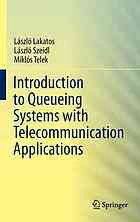Table Of ContentIntroduction to Queueing Systems
with Telecommunication Applications
La´szlo´ Lakatos (cid:129) L a´szlo´ Szeidl (cid:129) Mikl o´s Telek
Introduction to Queueing
Systems with
Telecommunication
Applications
123
La´szlo´ Lakatos La´szlo´ Szeidl
Eo¨tvo¨sLora´ndUniversity O´budaUniversity
Budapest,Hungary Budapest,Hungary
Sze´chenyiIstva´nUniversity
Miklo´sTelek
Gyo˝r,Hungary
BudapestUniversityofTechnology
andEconomics
Budapest,Hungary
ISBN978-1-4614-5316-1 ISBN978-1-4614-5317-8(eBook)
DOI10.1007/978-1-4614-5317-8
SpringerNewYorkHeidelbergDordrechtLondon
LibraryofCongressControlNumber:2012951675
MathematicsSubjectClassification(2010):60K25,68M20,90B22
©SpringerScience+BusinessMedia,LLC2013
Thisworkissubjecttocopyright.AllrightsarereservedbythePublisher,whetherthewholeorpartof
thematerialisconcerned,specificallytherightsoftranslation,reprinting,reuseofillustrations,recitation,
broadcasting,reproductiononmicrofilmsorinanyotherphysicalway,andtransmissionorinformation
storageandretrieval,electronicadaptation,computersoftware,orbysimilarordissimilarmethodology
nowknownorhereafterdeveloped.Exemptedfromthislegalreservationarebriefexcerptsinconnection
with reviews or scholarly analysis or material supplied specifically for the purpose of being entered
and executed on a computer system, for exclusive use by the purchaser of the work. Duplication of
this publication or parts thereof is permitted only under the provisions of the Copyright Law of the
Publisher’slocation,initscurrentversion,andpermissionforusemustalwaysbeobtainedfromSpringer.
PermissionsforusemaybeobtainedthroughRightsLinkattheCopyrightClearanceCenter.Violations
areliabletoprosecutionundertherespectiveCopyrightLaw.
Theuseofgeneraldescriptivenames,registerednames,trademarks,servicemarks,etc.inthispublication
doesnotimply,evenintheabsenceofaspecificstatement,thatsuchnamesareexemptfromtherelevant
protectivelawsandregulationsandthereforefreeforgeneraluse.
While the advice and information in this book are believed to be true and accurate at the date of
publication,neithertheauthorsnortheeditorsnorthepublishercanacceptanylegalresponsibilityfor
anyerrorsoromissionsthatmaybemade.Thepublishermakesnowarranty,expressorimplied,with
respecttothematerialcontainedherein.
Printedonacid-freepaper
SpringerispartofSpringerScience+BusinessMedia(www.springer.com)
Preface
The development of queueing theory dates back more than a century. Originally
theconceptwasexaminedforthepurposeofmaximizingperformanceoftelephone
operationcenters;however,itwasrealizedsoonenoughthatissuesinthatfieldthat
were solvable using mathematical models might arise in other areas of everyday
life as well. Mathematical models, which serve to describe certain phenomena,
quite often correspond with each other, regardless of the specific field for which
they were originally developed,be that telephone operation centers, planning and
management of emergency medical services, description of computer operation,
banking services, transportation systems, or other areas. The common feature in
theseareasisthatdemandsandservicesoccur(alsoatanabstractlevel)withvarious
contentsdependingonthegivenquestions.Inthecourseofmodeling,irrespective
of the meaning of demand and service in the modeled system, one is dealing
with only moments and time intervals. Thus it can be concluded that, despite the
diversityofproblems,acommontheoreticalbackgroundandamathematicaltoolkit
can be relied upon that ensures the effective and multiple application of a theory.
It is worth noting as an interesting aspect that the beginning of the development
of queueing theory is closely connected to the appearance of telephone operation
centersmorethanacenturyago,asdescribedpreviously;nevertheless,itstillplays
a significant role in the planning, modeling, and analyzing of telecommunication
networkssupplementedbyup-to-datesimulationmethodsandprocedures.
The authors of this book have been conducting research and modeling in
the theoretical and practical field of queueing theory for several decades and
teaching in both bachelor’s, master’s, and doctoral programs in the Faculty of
Informatics,Eo¨tvo¨sLora´ndUniversity,FacultyofEngineeringSciences,Sze´chenyi
Istva´n University, John von Neuman Faculty of Informatics, O´buda University
andthe FacultyofElectricalEngineeringandInformatics,BudapestUniversityof
TechnologyandEconomics(alllocatedinHungary).
Thevariousscientificbackgroundsoftheauthorscomplementeachother;there-
fore,bothmathematicalandengineeringapproachesarereflectedinthisbook.The
writingofthisbookwaspartlytriggeredbyrequestsfromundergraduateandPh.D.
studentsandbythesuggestionsofsupportivecolleagues,allofwhomexpressedthe
v
vi Preface
necessitytowriteabookthatcouldbedirectlyappliedtoinformatics,mathematics,
and applied mathematics education as well as other fields. In considering the
structureofthebook,theauthorstriedtobrieflysummarizethenecessarytheoretical
basisofprobabilitytheoryandstochasticprocesses,whichprovideauniformsystem
ofsymbolsandconventionstostudyandmasterthematerialpresentedhere.Atthe
end of Part I, the book provides a systematic and detailed treatment of Markov
chains, renewal and regenerative processes, Markov chains, and Markov chains
with special structures. Following the introductory chapters on probability theory
and stochastic processes, we will disregard the various possible interpretations
concerning the examples to emphasize terms, methodology, and analytical skills;
therefore,wewillprovidetheproofsforeachofthegivenexamples.Wethinkthat
this structure will help readers to study the material more effectively since they
may have different backgrounds and knowledge concerning this area. Regarding
the basics of probability theory, we refer the interested reader to the books
[21,31,38,84]. With respect to the general results of stochastic processes and
Markov chains, we refer the reader to the following comprehensive literature:
[22,26,35,36,48,49,54,71].
In Part II, the book introduces and considers the classic results of Markov
andnon-Markovqueueingsystems.Thenqueueingnetworksandappliedqueueing
systems(analysisof ATM switches, conflictresolutionmethodsof randomaccess
protocols,queueingsystemswithpriorities,andrepeatedordersqueueingsystems)
are analyzed. For more on the classic results of queueing theory, we refer the
reader to [8,20,39,51,55,69,82], whereas in connectionwith the moderntheory
ofqueueingandtelecommunicationsystemsthefollowingbooksmaybeconsulted:
[6,7,14–16,34,41,47,83], as well as results published mainly in journals and
conferencepapers.Thenumerousexercisesattheendofthechaptersensureabetter
understandingofthematerial.
A short appendix appears at the end of the book that sums up those special
conceptsandideasthatareusedinthebookandthathelpthereadertounderstand
thematerialbetter.
This work was supported by the European Union and cofinanced by the
EuropeanSocialFundunderGrantTA´MOP4.2.1/B-09/1/KMR-2010-0003andby
theOTKA GrantNo. K-101150.Theauthorsare indebtedto thePublisherforthe
encouragementandtheefficienteditorialsupport.
Thebookisrecommendedforstudentsandresearchersstudyingandworkingin
thefieldofqueueingtheoryanditsapplications.
Budapest,Hungary La´szlo´ Lakatos
La´szlo´ Szeidl
Miklo´sTelek
Contents
PartI IntroductiontoProbabilityTheoryandStochastic
Processes
1 IntroductiontoProbabilityTheory....................................... 3
1.1 SummaryofBasicNotionsofProbabilityTheory................ 3
1.2 FrequentlyUsedDiscreteandContinuousDistributions ......... 35
1.2.1 DiscreteDistributions..................................... 35
1.2.2 ContinuousDistributions ................................. 39
1.3 LimitTheorems..................................................... 44
1.3.1 ConvergenceNotions ..................................... 44
1.3.2 LawsofLargeNumbers .................................. 46
1.3.3 CentralLimitTheorem,Lindeberg–FellerTheorem .... 48
1.3.4 Infinitely Divisible Distributions and
ConvergencetothePoissonDistribution................. 49
1.4 Exercises ............................................................ 52
2 IntroductiontoStochasticProcesses ..................................... 55
2.1 StochasticProcesses................................................ 55
2.2 Finite-DimensionalDistributionsofStochasticProcesses........ 56
2.3 StationaryProcesses................................................ 57
2.4 GaussianProcess.................................................... 58
2.5 StochasticProcesswithIndependentandStationary
Increments........................................................... 58
2.6 WienerProcess...................................................... 58
2.7 PoissonProcess..................................................... 59
2.7.1 DefinitionofPoissonProcess............................. 59
2.7.2 ConstructionofPoissonProcess ......................... 62
2.7.3 BasicPropertiesofaHomogeneousPoissonProcess... 67
2.7.4 Higher-DimensionalPoissonProcess.................... 72
2.8 Exercises ............................................................ 76
vii
viii Contents
3 MarkovChains ............................................................. 77
3.1 Discrete-TimeMarkovChainswithDiscreteStateSpace ........ 78
3.1.1 HomogeneousMarkovChains ........................... 80
3.1.2 Them-StepTransitionProbabilities...................... 84
3.1.3 ClassificationofStatesofHomogeneous
MarkovChains............................................ 86
3.1.4 RecurrentMarkovChains................................. 91
3.2 FundamentalLimitTheoremofHomogeneousMarkov
Chains ............................................................... 96
3.2.1 PositiveRecurrentandNullRecurrentMarkov
Chains...................................................... 96
3.2.2 StationaryDistributionofMarkovChains............... 100
3.2.3 ErgodicTheoremsforMarkovChains................... 102
3.2.4 EstimationofTransitionProbabilities.................... 104
3.3 Continuous-TimeMarkovChains.................................. 105
3.3.1 Characterization of Homogeneous
Continuous-TimeMarkovChains........................ 106
3.3.2 StepwiseMarkovChains ................................. 109
3.3.3 ConstructionofStepwiseMarkovChains ............... 111
3.3.4 SomePropertiesoftheSamplePath
ofContinuous-TimeMarkovChains..................... 111
3.3.5 PoissonProcessasContinuous-TimeMarkovChain.... 113
3.3.6 ReversibleMarkovChains................................ 115
3.4 Birth-DeathProcesses .............................................. 116
3.4.1 SomePropertiesofBirth-DeathProcesses............... 116
3.5 Exercises ............................................................ 120
4 RenewalandRegenerativeProcesses..................................... 123
4.1 BasicTheoryofRenewalProcesses ............................... 123
4.1.1 LimitTheoremsforRenewalProcesses.................. 134
4.2 RegenerativeProcesses............................................. 137
4.2.1 EstimationofConvergenceRate
forRegenerativeProcesses ............................... 141
4.3 AnalysisMethodsBasedonMarkovProperty .................... 142
4.3.1 Time-HomogeneousBehavior............................ 143
4.4 AnalysisofContinuous-TimeMarkovChains .................... 143
4.4.1 AnalysisBasedonShort-TermBehavior ................ 145
4.4.2 AnalysisBasedonFirstStateTransition................. 146
4.5 Semi-MarkovProcess .............................................. 149
4.5.1 AnalysisBasedonStateTransitions ..................... 151
4.5.2 TransientAnalysisUsingtheMethod
ofSupplementaryVariables............................... 154
4.6 MarkovRegenerativeProcess...................................... 159
4.6.1 TransientAnalysisBased onEmbedded
MarkovRenewalSeries................................... 160
4.7 Exercises ............................................................ 163
Contents ix
5 MarkovChainswithSpecialStructures ................................. 165
5.1 PhaseTypeDistributions ........................................... 165
5.1.1 Continuous-TimePHDistributions ...................... 165
5.1.2 Discrete-TimePHDistributions.......................... 170
5.1.3 SpecialPHClasses........................................ 171
5.1.4 FittingwithPHDistributions............................. 173
5.2 MarkovArrivalProcess............................................. 173
5.2.1 PropertiesofMarkovArrivalProcesses.................. 176
5.2.2 ExamplesofSimpleMarkovArrivalProcesses ......... 178
5.2.3 BatchMarkovArrivalProcess............................ 180
5.3 Quasi-Birth-DeathProcess ......................................... 181
5.3.1 Matrix-GeometricDistribution........................... 183
5.3.2 Quasi-Birth-and-DeathProcesswithIrregular
Level0..................................................... 185
5.3.3 FiniteQuasi-Birth-and-DeathProcess ................... 186
5.4 Exercises ............................................................ 188
PartII QueueingSystems
6 IntroductiontoQueueingSystems........................................ 191
6.1 QueueingSystems .................................................. 191
6.2 ClassificationofBasicQueueingSystems......................... 192
6.3 QueueingSystemPerformanceParameters........................ 193
6.4 Little’sLaw.......................................................... 195
6.5 Exercises ............................................................ 197
7 MarkovianQueueingSystems ............................................ 199
7.1 M=M=1Queue...................................................... 199
7.2 TransientBehaviorofanM=M=1QueueingSystem............. 206
7.3 M=M=mQueueingSystem........................................ 214
7.4 M=M=1QueueingSystem........................................ 218
7.5 M=M=m=mQueueingSystem .................................... 219
7.6 M=M=1==N QueueingSystem.................................... 220
7.7 Exercises ............................................................ 222
8 Non-MarkovianQueueingSystems....................................... 225
8.1 M=G=1QueueingSystem.......................................... 225
8.1.1 DescriptionofM=G=1System........................... 225
8.1.2 MainDifferencesBetweenM=M=1andM=G=1
Systems.................................................... 226
8.1.3 MainMethodsforInvestigatingM=G=1System........ 227
8.2 EmbeddedMarkovChains ......................................... 227
8.2.1 Step(A):DeterminingQueueLength.................... 228
8.2.2 ProofofIrreducibilityandAperiodicity ................. 231
8.2.3 Step(B):ProofofErgodicity............................. 232
8.2.4 Pollaczek–KhinchinMeanValueFormula............... 232

